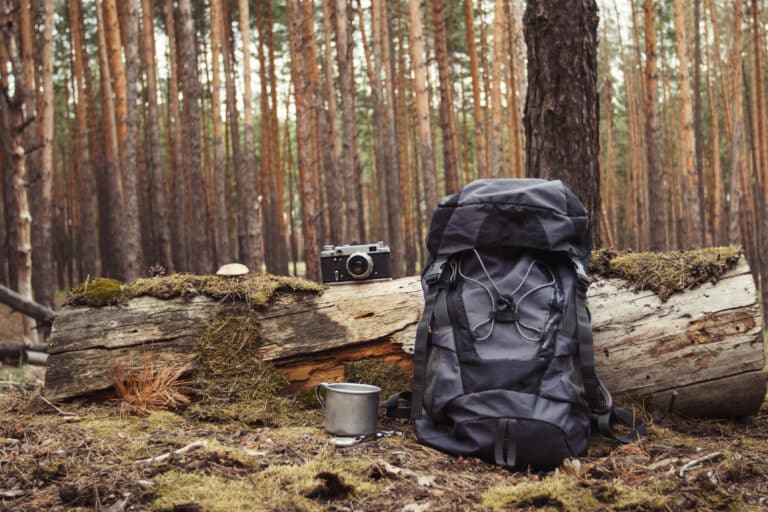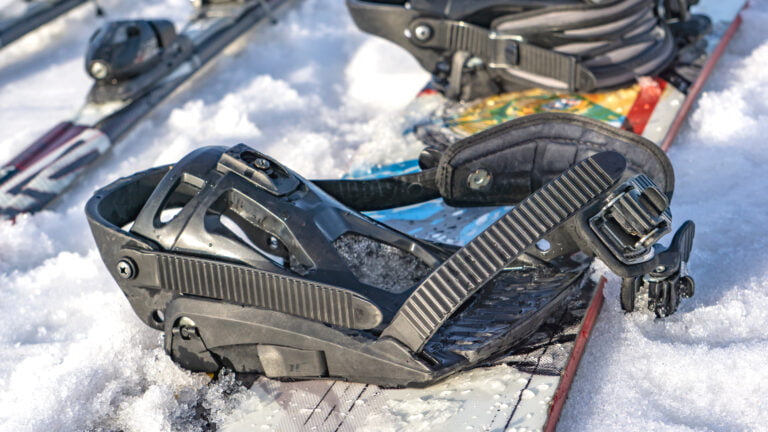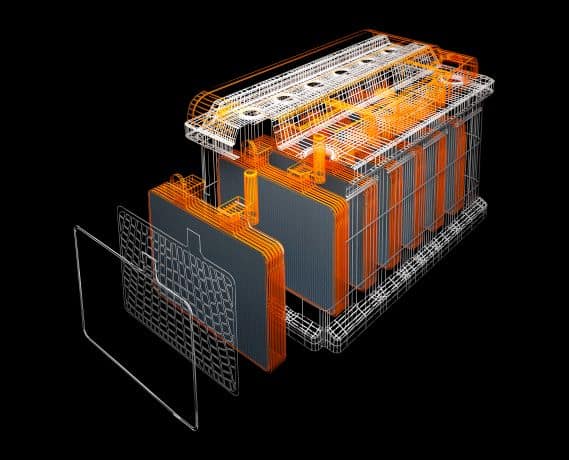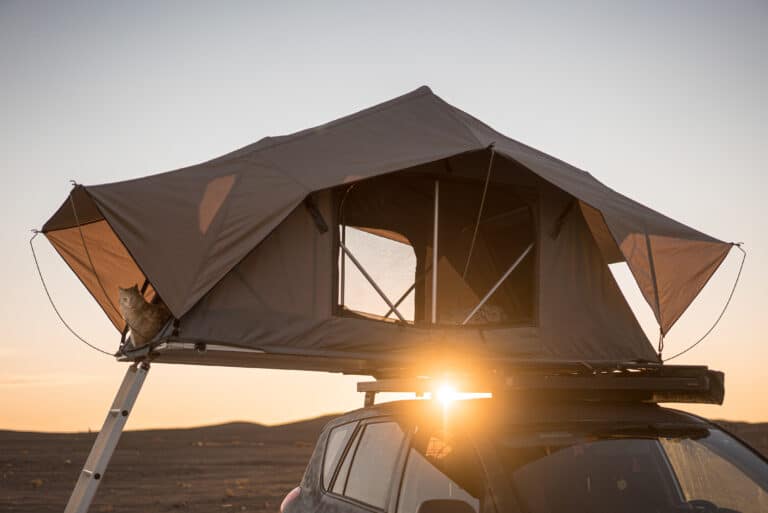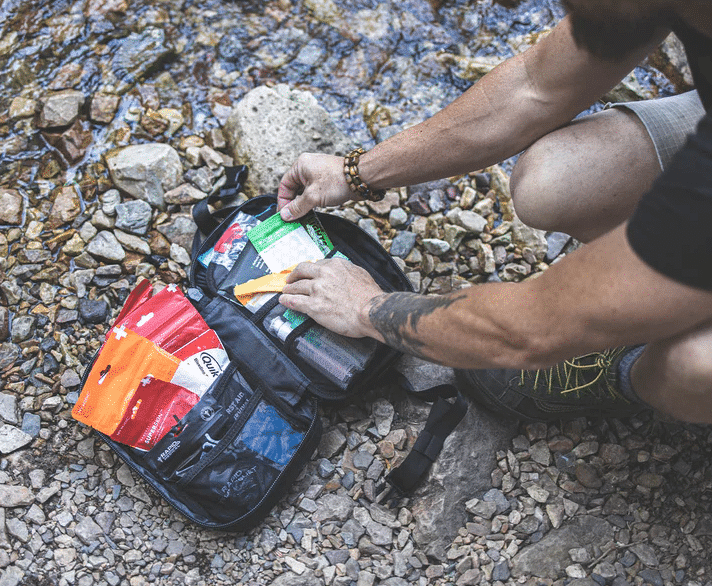The Best Ski Boots in 2024: Your Ultimate Guide
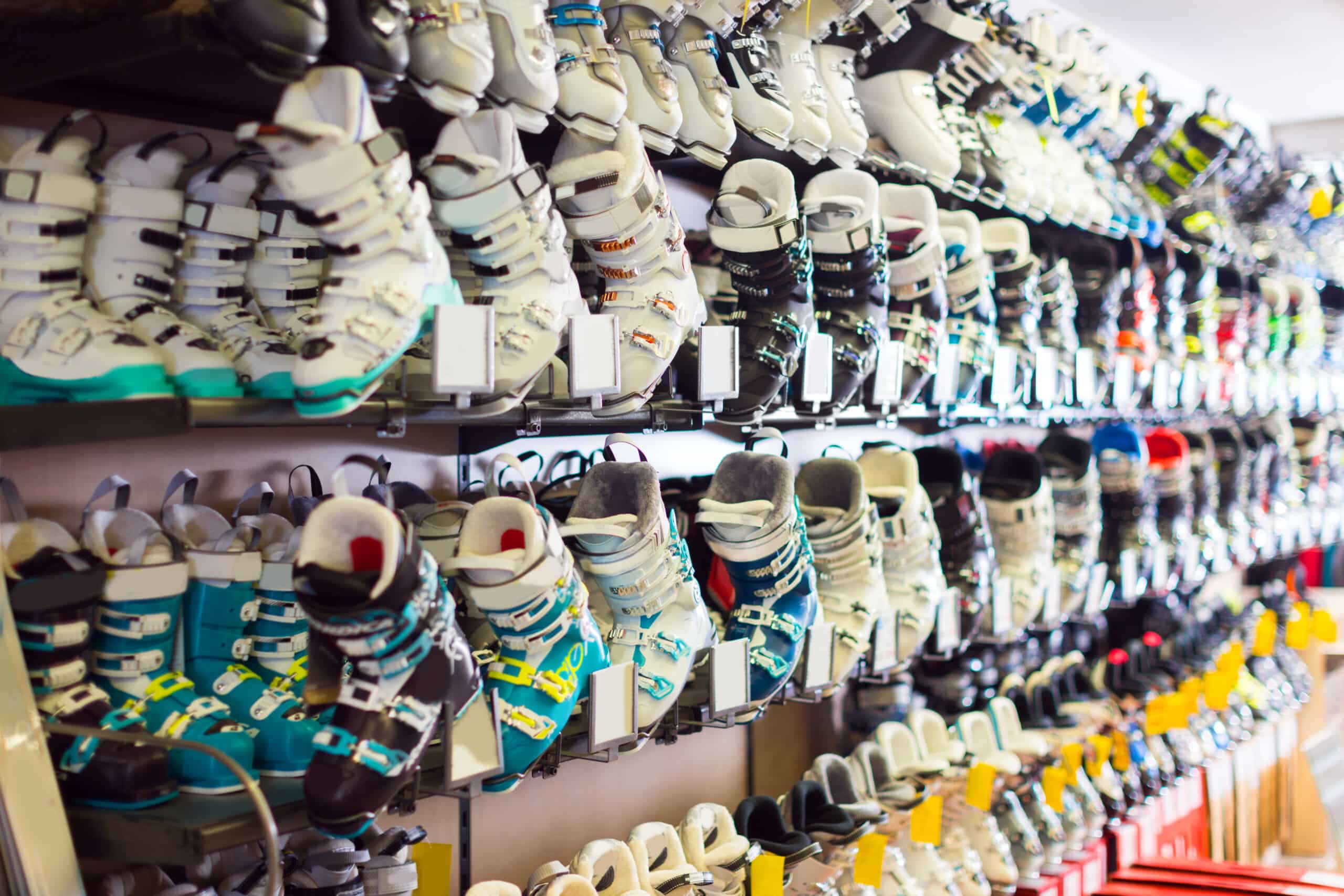
Our content may include affiliate links, through which we earn a small commission on purchases. Want to learn more about us? Read here.
Are you looking for the best ski boots for your next ski adventure? Whether you are an alpine skier who enjoys carving up groomed pistes or a backcountry skier insistent on finding untouched snow, having the right pair of ski boots is essential.
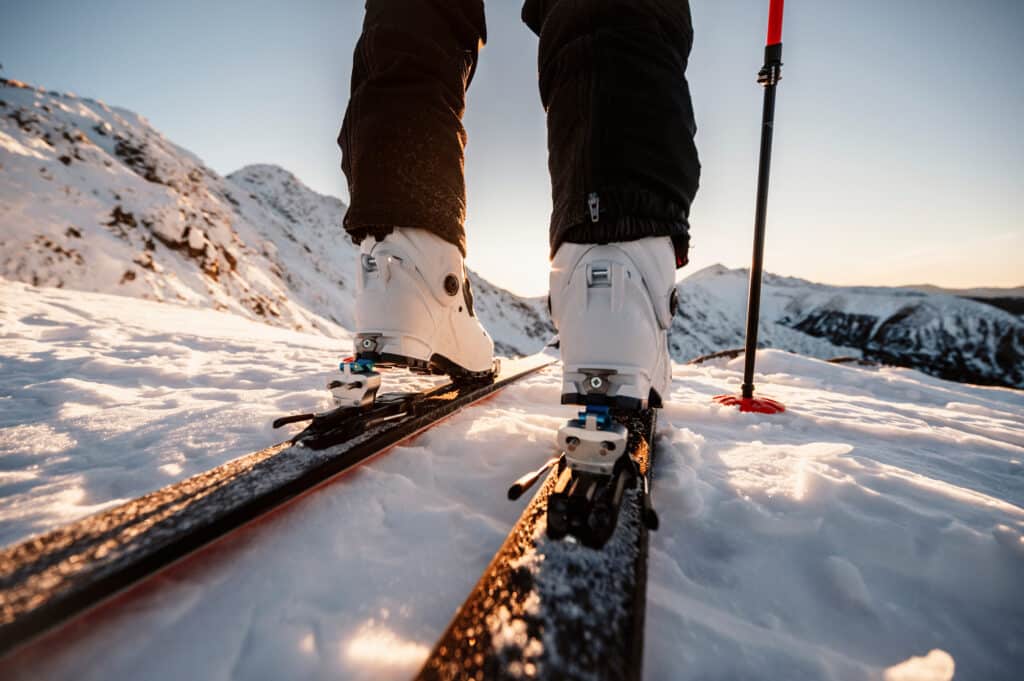
A good set of ski boots can help improve power transfer, comfort, and downhill control, so it pays off to ensure they fit perfectly.
Here, we will discuss the best winter 2024 ski boot models and dive into their features to give you an informed opinion on which one might suit your needs better.
What are the best ski boots?
The best ski boots will fit properly, have features that will compliment your abilities, and be comfortable for all-day charging down the hill. A properly fitting boot is paramount; otherwise, you will not have a great day on the mountain.
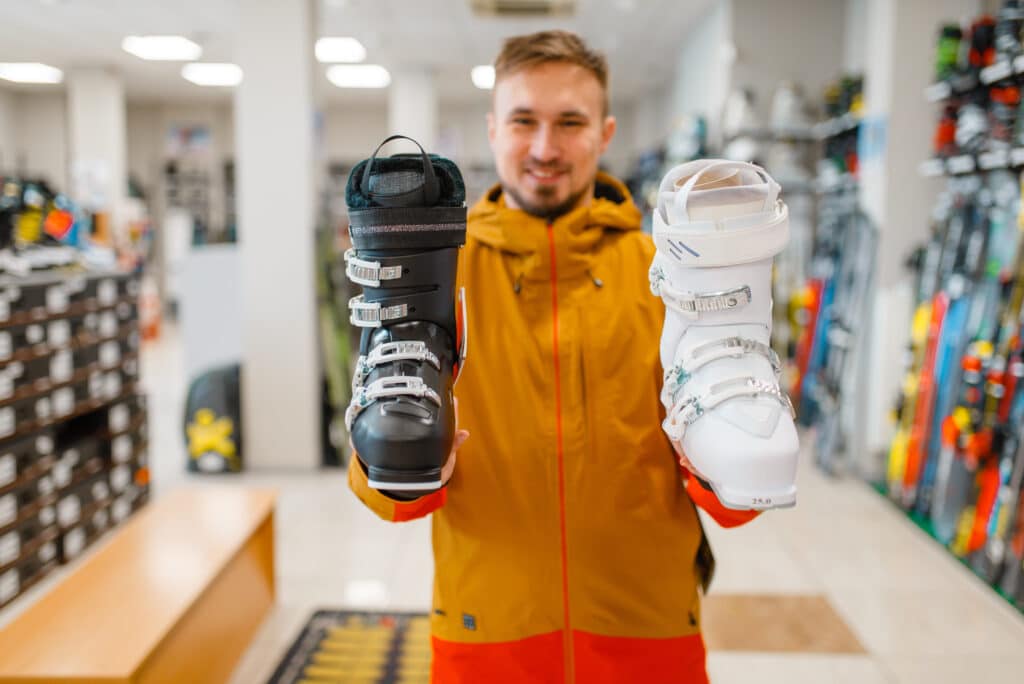
Below are several hand-picked boots that are the best for 2024. We have included alpine boots (downhill boots) and hybrid, backcountry, and touring boots.
So, whether you are a beginner skier, an intermediate, or an expert, there is something for everyone here.
- Best Alpine – Tecnica Mach1 MV 120
- Best Hybrid – Salomon Shift Pro 130 AT
- Best Alpine Intermediate – Salomon S/V Pro 100
- Best Alpine Budget – Dalbello Panterra 100 GW
- Best Alpine Beginners – Salomon QST Access 80
Tecnica Mach1 MV 120 TD GW
best overall alpine
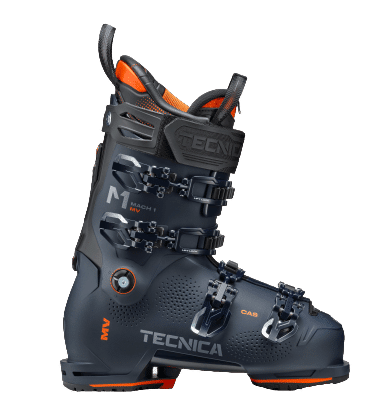
Overview
Features
A high-performance ski boot designed for advanced-level skiers with medium-volume feet looking for all-mountain performance, a comfortable but precise fit, and a high level of customization. T-Drive technology is a revolutionary shell-to-cuff connection that allows the boot to function much more efficiently, resulting in a smoother, more consistent flex, better performance, and less energy required to ski at a high level. The Asymmetrical Power Transmission shell and cuff design provide precision and comfort in any terrain.
- Flex: 120
- Last: 100
- Weight: 4 lbs 6.4 oz (1995g)
- Liner: C.A.S.- Celliant®
- Suited For: Alpine
MSRP $699.95
Pros
Cons
Our Take
As an avid skier who falls into the high-level intermediate to expert category, I’ve found this boot to be a game-changer. It’s incredibly solid and well-rounded, offering superb slope support and control. Initially, I faced some challenges getting my foot in, especially since the boot has a snug fit tailored for precision and responsiveness.
However, once my foot was in place, the difference in my skiing was remarkable. The boot provides an exceptional locked-in feel, greatly enhancing my confidence and control. It’s like once I’m in, I’m fully equipped to tackle any terrain with ease. For those with unique foot shapes, visiting a ski boot fitter for customization can make this already impressive boot even more comfortable and accommodating.
Salomon Shift Pro 130 AT
best overall hybrid
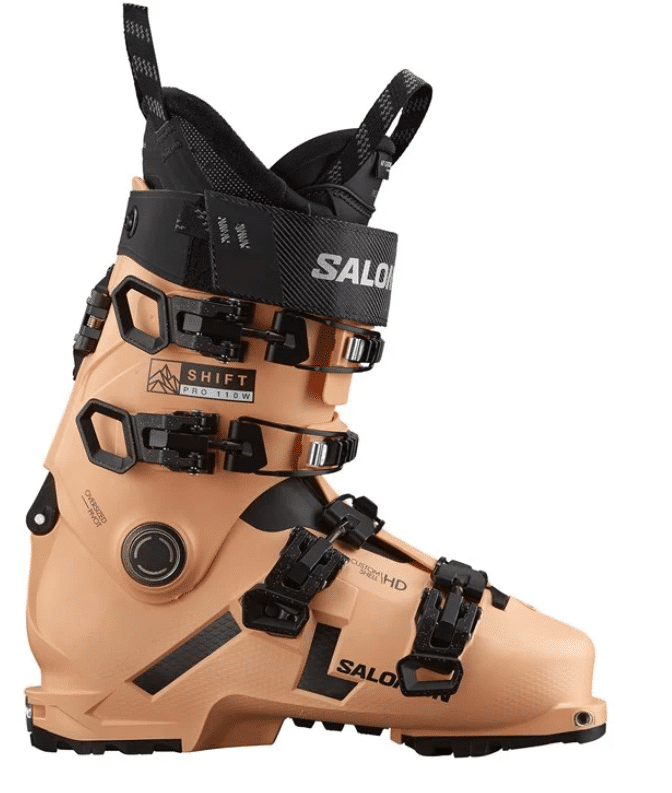
Overview
It is the perfect solution for skiers who want flexibility and comfort both in bounds and out. Compactly designed to provide stiffness and power, they have the alpine boot feel that keeps you upright and supported down the mountain while providing flexibility to withstand the unique challenge of backcountry terrain. Micro-adjustable buckles guarantee a snug fit even on the most challenging descents, giving skiers the flexibility they need to find footing in any environment. Whether hitting untouched powder in a new peak or cruising groomers at your local resort.
Features
- Flex: 130
- Last: 100
- Weight: 3 lbs 14.6 oz (1776g)
- Liner: CustomFit 4D Pro with thermoformable Talyn
- Suited For: Alpine and Backcountry
MSRP $700
Pros
Cons
Our Take
I absolutely love my Salomon Shift Pro ski bindings for their incredible blend of downhill performance and touring capability. From my experience, their versatility stands out the most, as I can easily switch between alpine and touring modes. This makes them perfect for both resort skiing and backcountry adventures.
What impresses me is their lightweight design, which allows for effortless movement without sacrificing safety or durability. The power transmission and responsiveness are top-notch, giving me a smooth and controlled skiing experience.
I also really appreciate the intuitive step-in mechanism and the reliable release system, making them high-performing but practical and convenient for any skiing situation. Do yourself a favor and check these boots out and pair them with your favorite all-mountain skis.
Salomon S/Pro MV 100
best alpine – intermediate
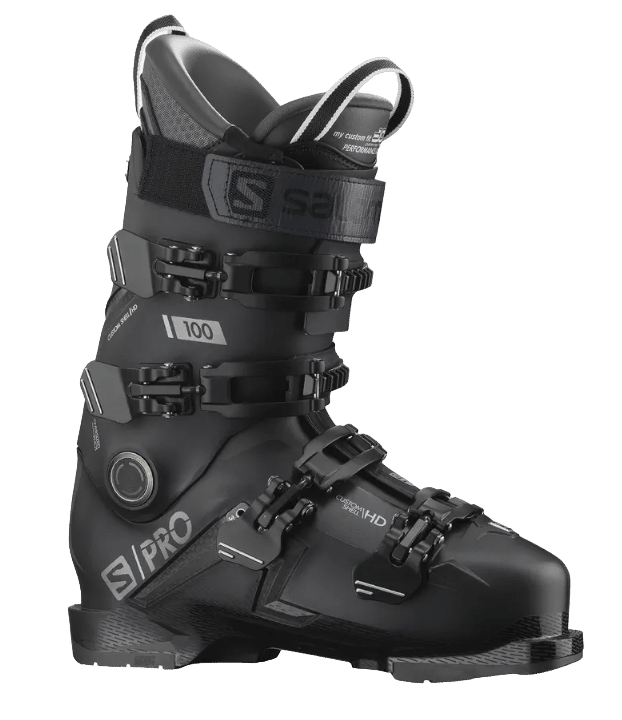
Overview
The perfect tool for skiers looking to excel on the slopes, this boot offers unparalleled comfort and performance. Its easy step-in design, durable seamless liner, and full customization capability promote an optimal fit so you can make each turn confidently, no matter how long you’re on the mountain.
Features
- Flex:100
- Last: 100
- Weight: 4 lbs 1.5 oz (1857g)
- Liner: Coreframe 360
- Suited For: Alpine groomers
MSRP $500
Pros
Cons
Our Take
I’ve been thoroughly impressed with the Salomon S/Pro MV 100. These boots are the epitome of comfort, designed with the needs of skiers in mind. The adjustable flex is a standout feature, allowing you to tailor the stiffness to your liking and skiing conditions. It will make a huge difference in your day on the slopes, offering support and flexibility when needed.
The S/Pro MV 100 strikes the perfect balance between performance and comfort, making it an ideal choice for those prioritizing a relaxed, enjoyable skiing experience without compromising quality. Whether cruising down groomed runs or tackling more challenging terrain, these boots will consistently enhance your skiing adventures.
Dalbello Panterra — Men’s 100 GW & Women’s 85 W GW
best Alpine Budget
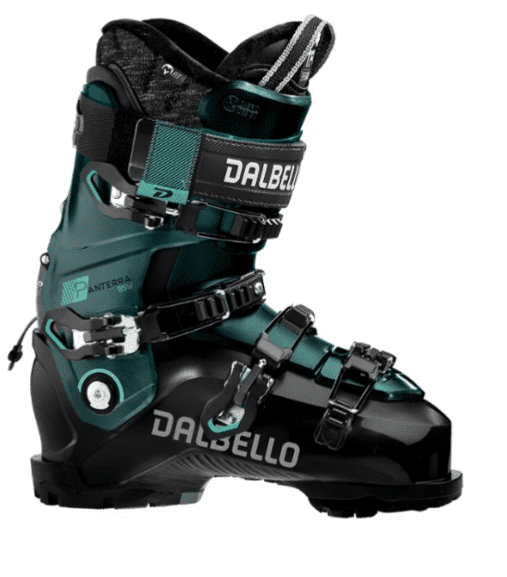
Overview
Comfort and performance with the 3-piece Cabrio construction. Its combination of an intelligent shell/cuff assembly with an external Kinetic Response tongue closure delivers comfortable power transmission, excellent shock absorption, and long-range flex. Updated Instant Fit liners feature warmth and shock absorption while firmly supporting the foot.
Features
- Flex: 100
- Last: 102
- Weight: 4 lbs 4 oz (1930g)
- Liner: Semi-Custom
- Suited For: Alpine all-mountain
MSRP $550
Pros
Cons
Our Take
As someone who loves to charge down the runs and explore off-piste terrain, the Dalbello Panterra has been a revelation. This boot perfectly balances aggressive performance and versatility, enabling me to confidently tackle various skiing conditions.
While not exactly budget-friendly, the $550 price tag feels completely justified, given the range of features packed into this boot. It’s not just about the sturdy build and precision control; the additional bells and whistles, like micro-adjustable buckles and a customizable fit, elevate the skiing experience to a whole new level.
Whether I’m carving down groomed trails or venturing into the backcountry, the Dalbello Panterra consistently delivers top-notch performance, making it a worthy investment for serious skiers seeking a high-quality, do-it-all ski boot.
Salomon QST Access — Women’s 70 W & Men’s 80
best alpine – beginners
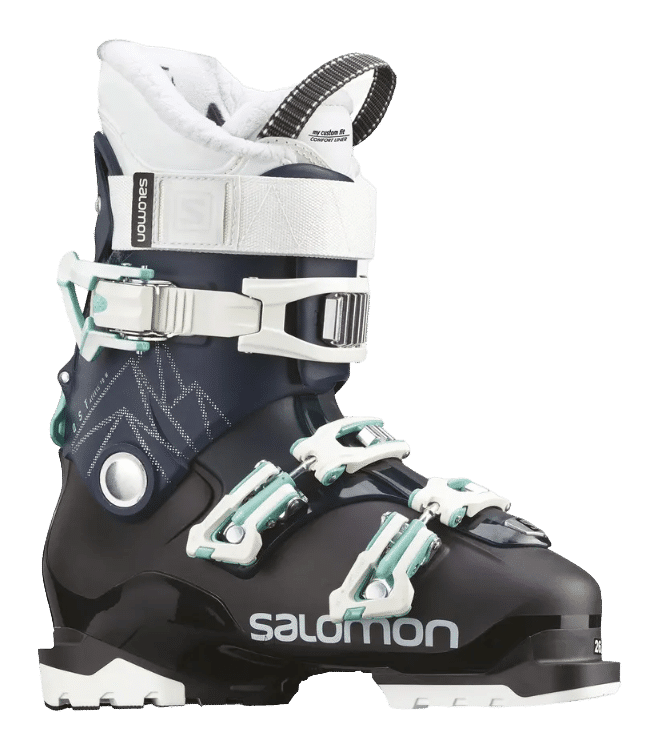
Overview
The QST ACCESS 70 Women snow boot makes skiing a breeze, thanks to its three dedicated features designed specifically for female skiers. The Slide-in liner provides easy step-in, and the adjustable ratchet buckle accommodates a wide range of calf sizes for a snug fit. The system makes walking easier with its backbone release and V-cut shape design, ensuring strong back support and progressive forward flex when skiing down.
Features
- Flex: 70
- Last: 104
- Weight: 3 lbs 6.4 oz (1542g)
- Liner: CustomFit comfort
- Suited For: Alpine groomers
MSRP $350
Pros
Cons
Our Take
If you’re a beginner or a skier who sticks mainly to groomed trails, the Salomon QST Access is a great choice for you. While it may not be packed with the latest technologies, its modest price of $350 makes it an attractive option.
This boot offers you the essential features needed for a comfortable and enjoyable skiing experience without overwhelming you with complexities. The QST Access provides a supportive and forgiving fit, which is ideal as you build your skills and confidence on the slopes. Its ease of use and straightforward design ensure that you can focus on improving your technique and enjoying your time on the mountain.
For its price, the Salomon QST Access is a solid, value-for-money choice that meets the needs of beginner to intermediate skiers looking for a reliable and comfortable boot.
Tecnica Cochise HV 120
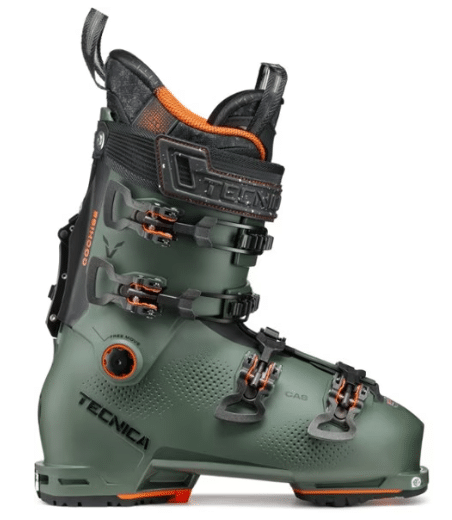
Overview
The Cochise HV 120 boot brings Tecnica’s outstanding performance to the walking sphere with its power and technology, making it one of the most versatile boots on the market. Outfitted with Tecnica’s award-winning C.A.S. shell and liner, this luxury piece of equipment provides a perfect fit from the get-go with all the customization options that feet require. Furthermore, the T-Ride walk mechanism re-engineers top-notch features from Tecnica’s Zero G line to create an exceptionally responsive boot that turns a downhill performance into a dream.
Features
- Flex: 120
- Last: 99
- Weight: 3 lbs 13.7 oz (1750g)
- Liner: Performance – C.A.S. – Celliant®
- Suited For: Alpine and Backcountry
MSRP $599.95
Pros
Cons
Our Take
If you’re an alpine and backcountry enthusiast looking for a boot that excels straight out of the box, the Tecnica Cochise HV 120 is an excellent choice for you. With its quick break-in time, you’ll find it ready for action almost immediately, saving you the usual prolonged period of discomfort. The stock soles are more than sufficient if your feet don’t require extra attention, providing ample support and comfort for most users.
This boot is a solid choice, balancing performance and ease of use. Whether carving down groomed runs or venturing off into the backcountry, the Tecnica Cochise HV 120 will reliably support your adventures, offering both durability and comfort in a package ready to perform from the moment you step in.
Atomic Hawx Prime 120 S GW

Overview
This boot offers an ideal fit for medium-wide forefeet and medium calf volume. Yet, its groundbreaking Power Shift technology allows you to adjust the degrees of the shaft for a personalized feel. Memory Fit thermal molding prevents cold feet with Thinsulate liners and ensures secure footing no matter how extreme the conditions. And a softer instep area, slipping your foot in and out is fast and easy.
Features
- Flex:120
- Last: 102
- Weight: 4 lbs 5.7 oz (1976g)
- Liner: Mimic Platinum Liner
- Suited For: Alpine All-Mountain
MSRP $699.95
Pros
Cons
Our Take
If you’re a skier who loves charging down the mountain and values responsiveness in your gear, the Atomic Hawx Prime 120 S GW is a great choice for you. It’s important to note that this is a heavier boot, which might not suit everyone’s preference. However, its stiffness is a major advantage for aggressive skiing, offering you the stability and control needed for high-speed descents and dynamic turns.
The boot’s responsiveness is a standout feature, ensuring that your movements are precisely translated to your skis. Additionally, the Atomic Hawx Prime 120 S GW allows for micro-adjustments, enabling you to fine-tune it for maximum comfort and a custom fit.
This capability makes it versatile, allowing you to adapt the boot to your individual needs and preferences, ensuring a satisfying and high-performance skiing experience.
Nordica Speedmachine 3 100
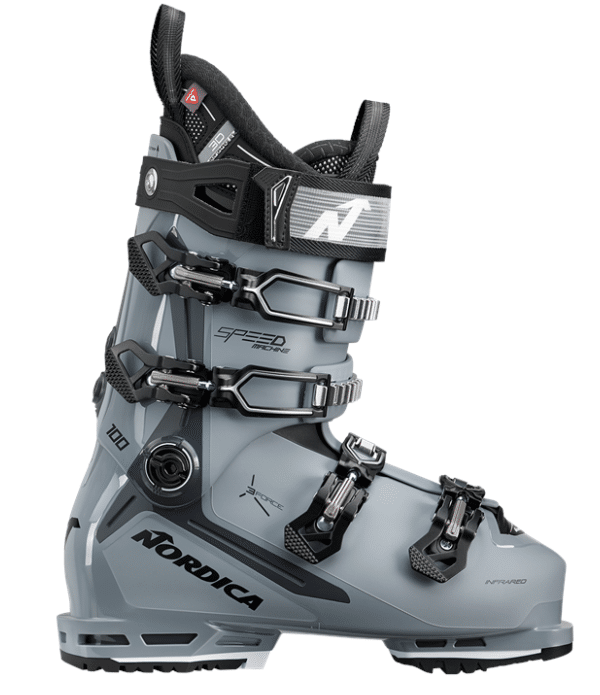
Overview
The Nordica Speedmachine 3 100 boot is an all-mountain staple redesigned to amp up your riding experience. Its 3 Force technology enhances energy transition from the leg and foot to the liner and shell for more power, outstanding performance, and improved efficiency. Nordica crafted the boot with a softer flex and a customizable liner and shell.
Features
- Flex:100
- Last: 102
- Weight: 3 lbs. 15.5 ozs.
- Liner: 3D Cork Fit Primaloft
- Suited For: Alpine All-Mountain
MSRP $449.99
Pros
Cons
Our Take
If you often struggle with cold feet on the slopes, the Nordica Speedmachine 3 100 could be the answer you’re looking for. Although you might find its flex a bit soft, especially if you’re used to stiffer boots, the exceptional warmth these boots provide is a standout feature. This makes them particularly suitable for skiers prioritizing comfort and warmth in colder conditions.
The customizable fit is also a huge benefit if you have specific foot issues. This feature allows you to tailor the boot to your needs, ensuring warmth and a comfortable and supportive fit throughout your skiing sessions. If warmth and customizability are high on your list, the Nordica Speedmachine 3 100 is definitely worth considering.
Scott Freeguide Carbon
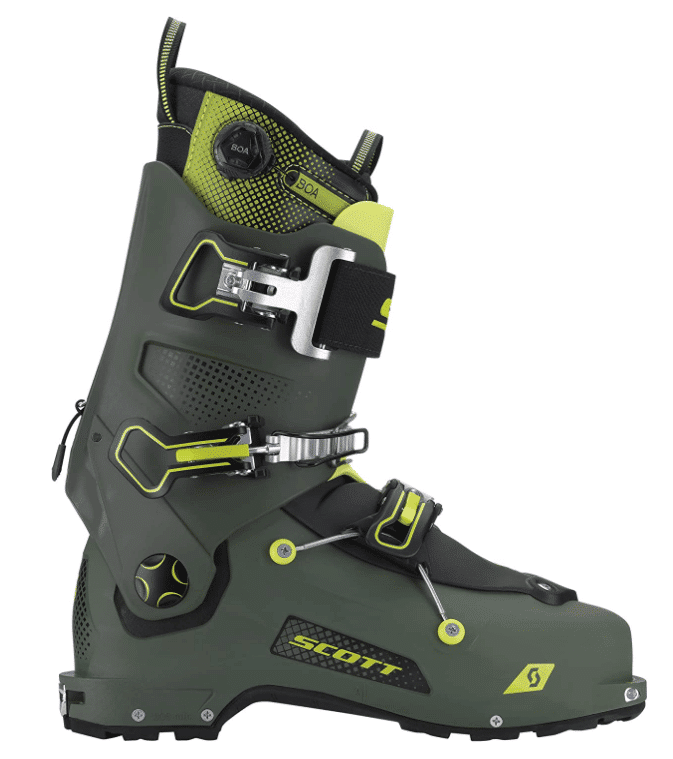
Overview
It is built with a carbon fiber shell and offers robust energy transmission, providing supreme downhill performance and control. Additionally, walkability is enabled by an integrated ski/walk mechanism, utilizing a two-part tongue that permits cuff rotation up to 60°. Using its micro-adjustable locking system, a state-of-the-art inner liner with BOA® Fit System ensures comfort, warmth, and incredible precision.
Features
- Flex: 130
- Last: 101
- Weight: 3 lbs 3.3 oz (1455g)
- Liner: Thermo and Memo fit liner foam
- Suited For: Alpine, Backcountry, Mountaineering
MSRP $699.99
Pros
Cons
Our Take
If you’re a backcountry enthusiast or even an occasional alpine skier, the Scott Freeguide Carbon is an investment that’s likely to pay off for you. Yes, it’s on the expensive side, but the value it delivers is undeniable. These boots are exceptionally well-built and lightweight, making them perfect for long days of exploring untracked terrain.
The BOA securement system is a huge bonus, offering you a precise, dialed-in fit that’s easy to adjust, even in the middle of a snowy adventure. This feature enhances comfort and significantly improves performance by ensuring your feet are securely held in place.
The combination of durability, lightness, and the innovative BOA system makes the Scott Freeguide Carbon a top choice for serious backcountry and alpine skiers who are willing to invest in high-quality, high-performance gear.
Comparison Table – Ski Boots
[wptb id=9618]
Ski Boot Fit
Ensuring a proper fit in a ski boot is paramount for an enjoyable and safe skiing experience. A well-fitted ski boot provides the necessary support, control, and responsiveness needed to navigate varying terrains.
A snug fit not only enhances comfort but also minimizes the risk of blisters, hot spots, and other discomforts that can arise from an ill-fitting boot. The right fit ensures optimal power transfer, allowing skiers to maneuver with precision and confidence on the slopes.
Additionally, a properly fitted boot contributes to better circulation and warmth, which is crucial for staying comfortable in cold mountain conditions. Whether you’re a novice or an expert, investing the time to find the right size and shape for your foot with the assistance of a professional boot fitter can make a significant difference in your skiing performance and overall enjoyment on the mountain.
Ski Boot Liner
Ski boot liners are a form of specialized footwear designed to give skiers comfort, warmth, and support while they make their way down the slopes. Boot liners are essential for any skier looking to stay warm and comfortable on the slopes.
Whether you’re a beginner or an expert, having a good liner will make all the difference in your experience.
Ski boots come in several options, but in the most basic sense, they are either open-cell or closed-cell liners, providing different insulation and cushioning levels. Open cell liners are typically made from foam materials that mold quickly to the foot, providing more insulation and comfort.
Closed cell liners are usually stiffer and provide better ankle support but may not be as insulated as open cell options. Ultimately, it depends on personal preference – some people prefer extra insulation, while others may prioritize ankle support over warmth.
If you’re really looking to level up your ski boot fit, consider going for a heat-moldable liner. Your local ski shop will have a boot fitter who can customize your liners and have other techniques to adjust the shell of your boot for the perfect custom fit.
Why does it matter? Well, a properly sized ski boot liner isn’t just about comfort – it’s the secret sauce for nailing that perfect slope fit and boosting your overall performance.
What is GripWalk?
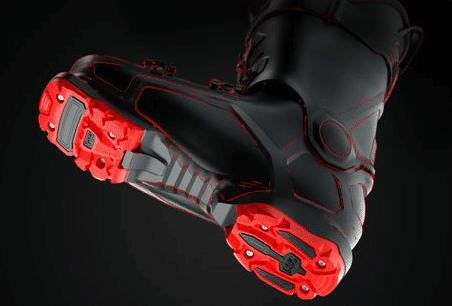
In 2016, Marker brought to market a proprietary ski boot sole and binding technology called GripWalk. This revolutionary technology was initially introduced on Dalbello boots to facilitate more accessible and safer walking off the slopes.
As interest in GripWalk increased, more brands began licensing the technology; now, most ski boots feature GripWalk soles, and many bindings across brands utilize GW technology, as indicated by “GW” in the model name.
This modern tech offers skiers more convenience when taking a break from skiing thanks to its design that does not require any toe height adjustment for either traditional alpine soles or for GripWalk when using Marker’s compatible bindings.
Thanks to GripWalk, skiers can enjoy added ease as they move between the slopes and beyond.
What is flex in a ski boot?
Flex refers to the stiffness or softness of the material the boot is made out of. It’s a way to measure how much lateral pressure needs to be applied before the boot’s cuff begins to move. The flex rating is typically in the boot’s name and will range from 60 to 140.
Ski boots with high flex are typically seen on more advanced skiers as they provide more control on steep and rugged terrain due to added stiffness. On the other hand, ski boots with lower flex are better suited for less experienced skiers as they provide extra mobility and comfort while skiing which helps build confidence in new skiers.
Flexibility in ski boots is an important feature that should be considered when picking out a new pair of boots, depending on your level of expertise, so you have the right balance between maneuverability and control.
What is last on ski boots?
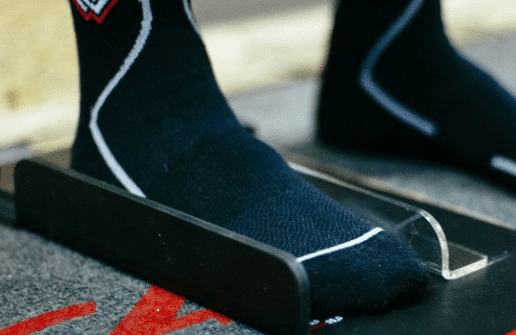
Ski boots come in widths and shapes, determined by the boot’s last. The Last is the innermost shape of the boot that determines how narrow or wide it is – typically measured in millimeters.
Boot companies design several different lasts, ranging from very narrow 95mm to extra wide 104mm variations. Choosing the right Last for your foot shapes and skiing style can make a huge difference when out on the slopes – ensuring comfortable performance.
Is it better to have ski boots tight or loose?
Is it better to have ski boots tight or loose? This has been a question ski enthusiasts have debated for years. The answer isn’t straightforward, as it depends entirely on an individual’s preferences and skiing style.
For alpine skiers, ski boots should be tight enough to support and control while skiing at high speeds. Ensure the toe box is snug, so your foot doesn’t lift up when you ski, which can cause discomfort. You should also be able to wiggle your toes comfortably without feeling constricted or squished.
For backcountry skiers, ski boots should fit snugly but not too tight – remember that your feet will expand while skiing, and you don’t want them to become uncomfortable. Ensure the ski boot has enough room to accommodate your ski socks.
How to maintain and care for your ski boots?
Maintaining the longevity of your ski boots is crucial for ensuring optimal performance and comfort on the slopes. Here are additional tips to help you care for your ski boots:
Proper Fit: Start with the right size of ski boots. Boots that are too tight or too loose can lead to discomfort and impact the lifespan of the boots. Visit a professional boot fitter to ensure a proper fit, and consider custom insoles for added comfort.
Annual Inspection: Before each skiing season, thoroughly inspect your boots for any visible signs of damage or wear. Check the buckles, straps, and shell for cracks, loose screws, or other issues. Identifying problems early allows for timely repairs and avoids midmountain gear failure.
Avoid Walking in Ski Boots: Walking in ski boots, especially on hard surfaces like pavement, can cause premature wear on the soles and affect the overall durability. Bring a pair of snow boots for walking to and from the slopes. Plus it’s all too common to hear of parking lot falls and injuries that cut the season short.
Buckles and Straps: Keep the buckles and straps clean to ensure smooth functionality. Use a small brush or toothpick to remove any debris lodged in the buckles. Lubricate moving parts with a silicone-based spray to prevent rust and corrosion. Fasten the buckles and straps when storing the boots to maintain their shape and prevent unnecessary stress on these components.
Dry Boots Properly: Moisture can damage the liners and promote the growth of mold and mildew. After each use, remove the liners and let them air dry. Use a boot dryer or stuff the boots with newspaper to absorb any remaining moisture.
Rotate Usage: If you have multiple pairs of ski boots, consider rotating their usage. This allows each pair to have time to air out and reduces the overall wear on any single set.
Use Boot Dryers: Invest in a boot dryer to thoroughly dry the interior of your boots after each use. This not only prevents unpleasant odors but also helps maintain the integrity of the liners and other internal components.
Avoid Excessive Sun Exposure: Prolonged exposure to direct sunlight can cause the materials of your ski boots to deteriorate. When not in use, store your boots in a shaded area or use a boot bag to protect them from UV rays.
Replace Worn-out Components: Components such as heel and toe pads and power straps can wear out over time. Regularly inspect and replace these parts as needed to maintain your ski boots’ overall performance and safety.
Store Boots Properly in the Off-Season: When storing your ski boots for an extended period, follow proper storage procedures. Clean them thoroughly, ensure they are completely dry, secure the buckles and power strap, and store them in a cool, dry place away from direct sunlight. Avoid leaving them in a car or garage where temperature fluctuations can occur.
By incorporating these additional tips into your ski boot maintenance routine, you’ll extend their lifespan and enhance your overall skiing experience. Proper care ensures that your boots continue to provide the support, comfort, and performance you need on the slopes.
What are the best ski boots?
The best ski boot is going to be the one that does not leave you cursing at your boots at the end of the day; ill-fitting boots are not good. Comfort is a huge factor when it comes to your alpine ski boots.
There is much to be said about the technology of customizable liners that will conform to your feet. When it comes to flex, the boot that allows you to ski to your abilities and improve upon them is best.
If your epic day is cruising groomers all day, then maybe all-mountain ski boots are not for you.
Or, if you enjoy an excellent resort day but love to get out into the backcountry, you need to check out a hybrid boot. The Salomon S/Pro AT is our go-to boot.
Conclusion
No one ski boot is the best ski boot for everyone. It is essential to find ski boots that fit your foot and skiing style and ski boots with the right flex and features to help you ski better.
Several brands and models on the market offer different levels of comfort and performance; take your time researching ski boots until you find the perfect one!
You can confidently charge down any mountain terrain with the proper ski boots – groomers, powder, or backcountry.
Happy skiing!

